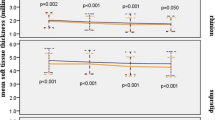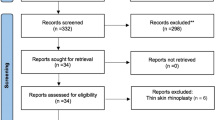Abstract
Background
Rhinoplasty is one of the most common cosmetic surgeries. Different factors affect outcome of rhinoplasty. This study aim was to investigate the effect of nasal skin thickness on the outcome of rhinoplasty.
Methods
This prospective cohort study was performed on 100 applicants for rhinoplasty aged between 18 and 40 years. Demographic information was collected, and skin color and type were determined using Fitzpatrick criterion. Nose skin thickness was measured by caliber, and ROE (Rhinoplasty Outcome Evaluation) and NOSE (Nasal Obstruction Symptom Evaluation) questionnaires were completed before and three and six months after surgery.
Results
The mean age of the participants was 27.6 ± 6.5 years and most of them were female. The mean thickness of nasal skin in three regions including alar, dorsal, and supratip was 3.72 ± 0.78, 3.81 ± 0.82, and 4.66 ± 1.47 mm, respectively. There was a significant relationship between nasal skin thickness and satisfaction with the outcome of rhinoplasty (ROE) and people with low skin thickness were more satisfied with the outcome of surgery (p < 0.05). Also, there was a significant association between nasal skin thickness and nasal obstruction (NOSE score) after surgery and individuals with low skin thickness had less nasal obstruction after surgery (p < 0.05).
Conclusions
This study showed that people with thicker nasal skin are less satisfied with the outcome of their nose surgery, and therefore, more care should be considered for such people during and after surgery. However, skin type and color have no effect on the outcome of rhinoplasty.
Level of Evidence: Level III, Risk - Prognostic Study
Similar content being viewed by others
Data Availability
Data is available on request.
References
Hawrami FAH, Amin ZM, Mahmood M, Hama RA (2020) Evaluation esthetic and functional outcomes after rhinoplasty. J Contemp Med Sci 6:50–53
Rohrich RJ, Afrooz PN (2019) Primary open rhinoplasty. Plast Reconstruc Surg 144:102e–117e
The International Society of Plastic Surgery (2018) ISAPS global statistics. Available from: https://www.isaps.org/. Accessed 10 Nov 2022
American Society of Plastic Surgeons (2020) Plastic surgery statistics report. [cited 2022 Nov. 1]; Available from: https://www.plasticsurgery.org/news/plastic-surgery-statistics. Accessed 15 Sep 2023
American Society of Plastic Surgeons (2018) Plastic surgery statistics report. Available from: https://www.plasticsurgery.org/documents/News/Statistics/2018/plastic-surgery-statistics-full-report-2018.pdf. Accessed Aug 2023
Dimitrios K, Panagiotis M, Stylianos K, Nikolaos D, Thomas N (2017) Assessment of aesthetic results of 100 patients who underwent rhinoplasty-rhinoplasty outcome evaluation. Plast Reconstr Surg Global Open 5:e1404
Teitelbaum JI, Barrett DM (2020) Nasal airway obstruction structure and function. JAMA Otolaryngol-Head Neck Surg 146:512–515
Ishii LE, Tollefson TT, Basura GJ et al (2017) Clinical practice guideline: improving nasal form and function after rhinoplasty. Otolaryngol Head Neck Surg 156:S1–S30
Bilgen F, Ince B, Ural A, Bekerecioglu M (2020) Disastrous complications following rhinoplasty: soft tissue defects. J Craniofac Surg 31:809–812
Sharif-Askary B, Carlson AR, Van Noord MG, Marcus JR (2020) Incidence of postoperative adverse events after rhinoplasty: a systematic review. Plast Reconstruc Sur 145:669–684
Abbas OL (2016) Revision rhinoplasty: measurement of patient-reported outcomes and analysis of predictive factors. Springerplus 5:1472
Jomah J, Elsafi RA, Ali KSAE, Abdullah R, Gelidan AG (2019) Nasal Skin thickness measurements using computed tomography in an adult Saudi population. Plast Reconstruc Surg Global Open 7:e2450
Dey JK, Recker CA, Olson MD et al (2019) Assessing nasal soft-tissue envelope thickness for rhinoplasty: normative data and a predictive algorithm. JAMA Fac Plast Surg 21:511–517
Gentile P, Storti G, De Angelis B, Albano A, Cervelli V (2019) Literature scans: cartilage grafts in nasal tip rhinoplasty. Eur J Plast Surg 42:415–422
Fasugba O, Gardner A, Smyth W (2014) The Fitzpatrick skin type scale: a reliability and validity study in women undergoing radiation therapy for breast cancer. J Wound Care 23:358–368
Özkul MH, Kocagöz DG, Balıkcı HH, Verim A, Yaşar H (2013) A practical method for assessing nasal skin quality. Eur Arch Oto-Rhino-Laryngol 270:1839–2142
Alsarraf R (2000) Outcomes research in facial plastic surgery: a review and new directions. Aesthetic Plast Surg 24:192–197
Çelik M, Altıntaş A (2019) The turkish version of the rhinoplasty outcomes evaluation questionnaire: validation and clinical application. Balkan Med J 36:129
Izu SC, Kosugi EM, Lopes AS et al (2014) Validation of the rhinoplasty outcomes evaluation (ROE) questionnaire adapted to Brazilian Portuguese. Qual Life Res 23:953–958
Mohammadshahi M, Pourreza A, Orojlo PH, Mahmoodi M, Akbari F (2014) Rhinoplasty as a medicalized phenomenon: a 25-center survey on quality of life before and after cosmetic rhinoplasty. Aesthetic Plast Surg 38:615–619
Stewart MG, Witsell DL, Smith TL, Weaver EM, Yueh B, Hannley MT (2004) Development and validation of the Nasal Obstruction Symptom Evaluation (NOSE) scale. Otolaryngol Head Neck Surg 130:157–163
Onerci Celebi O, Araz Server E, Yigit O, Longur ES (2018) Adaptation and validation of the Turkish version of the Nasal Obstruction Symptom Evaluation scale. Int Forum Allergy Rhinol 8:72–76
Fatemi MJ, Rajabi F, Moosavi SJ, Soltani M (2012) Quality of life among Iranian adults before and after rhinoplasty. Aesthet Plastic Surg 36:448–452
Kosins AM, Obagi ZE (2017) Managing the difficult soft tissue envelope in facial and rhinoplasty surgery. Aesthet Surg J 37:143–157
Gruber RP, Shih HB, Lin WC (2017) Commentary on: managing the difficult soft tissue envelope in facialand rhinoplasty surgery. Aesthet Surg J 37:158–160
Khan N, Rashid M, Khan I et al (2019) Satisfaction in patients after rhinoplasty using the Rhinoplasty Outcome Evaluation questionnaire. Cureus 11:e5283
Zojaji R, Sobhani E, Keshavarzmanesh M, Dehghan P, Meshkat M (2019) The association between facial proportions and patient satisfaction after rhinoplasty: a prospective study. Plast Surg 27:167–172
Lavinsky-Wolff M, Camargo HL Jr, Barone CR et al (2013) Effect of turbinate surgery in rhinoseptoplasty on quality-of-life and acoustic rhinometry outcomes: a randomized clinical trial. Laryngoscope 123:82–89
Yeung A, Hassouneh B, Kim DW (2016) Outcome of nasal valve obstruction after functional and aesthetic-functional rhinoplasty. JAMA Fac Plast Surg 18:128–134
Cho GS, Kim JH, Yeo N-K, Kim SH, Jang YJ (2011) Nasal skin thickness measured using computed tomography and its effect on tip surgery outcomes. Otolaryngol Head Neck Surg 144:522–527
Boahene KD (2020) The African rhinoplasty. Fac Plast Surg 36:46–52
Alharethy S, Mousa A, Alharbi A, Aldrees T, AlQaryan S, Jang Y-J (2018) Does skin thickness affect satisfaction post rhinoplasty?: Middle Eastern population as an example. Saudi Med J 39:1238
Patrocínio LG, Patrocínio JA (2007) Open rhinoplasty for African-American noses. Br J Oral Maxillofac Surg 45:561–566
Nuyen B, Spataro EA, Olds C, Kandathil CK (2019) Most SP, Relationship of sociodemographic factors and outcomes in functional rhinoplasty. Fac Plast Surg 35:85–89
Barone M, Cogliandro A, Salzillo R, Ciarrocchi S, Panasiti V, Coppola R et al (2020) The role of skin thickness in the choice of a rhinoplasty technique for thin-skinned patients: analysis of long-term results and patient satisfaction. Aesthetic Plast Surg 44(5):1742–1750
Funding
This study received no fund.
Author information
Authors and Affiliations
Contributions
RZ: main concept and study design and approving final manuscript; MA: PI and data acquisition and approving final manuscript; SHZ: data collection and writing first manuscript draft and approving final manuscript; and MM: data analysis and interpretation of results and approving final manuscript.
Corresponding author
Ethics declarations
Ethical approval
All procedures were in accordance with the 1964 Helsinski Declaration and its later amedments. The ethics committee of the Islamic Azad University of Mashhad approved the study protocol.
Consent to participate
Informed consent was obtained from all participants before enrollment.
Consent to publish
All authors consented to publish the manuscript.
Competing interests
Ramin Zojaji, Maryam Ataei, Seyedeh Hasti Zojaji, and Mojtaba Meshkat declare no competing interests.
Additional information
Publisher's Note
Springer Nature remains neutral with regard to jurisdictional claims in published maps and institutional affiliations.
Rights and permissions
Springer Nature or its licensor (e.g. a society or other partner) holds exclusive rights to this article under a publishing agreement with the author(s) or other rightsholder(s); author self-archiving of the accepted manuscript version of this article is solely governed by the terms of such publishing agreement and applicable law.
About this article
Cite this article
Zojaji, R., Ataei, M., Zojaji, S.H. et al. The effect of nasal skin thickness on the outcome of rhinoplasty. Eur J Plast Surg 47, 6 (2024). https://doi.org/10.1007/s00238-023-02156-z
Received:
Accepted:
Published:
DOI: https://doi.org/10.1007/s00238-023-02156-z




